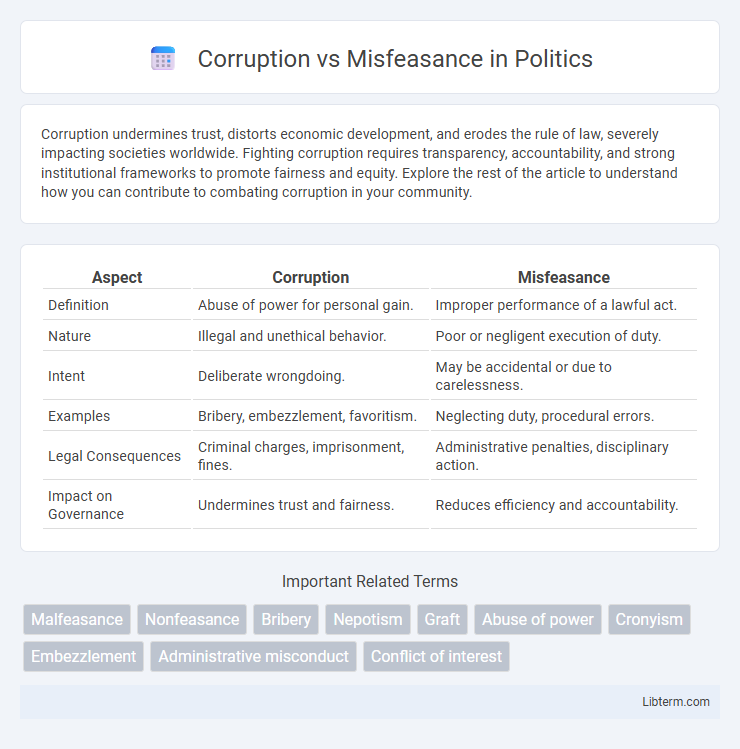Corruption undermines trust, distorts economic development, and erodes the rule of law, severely impacting societies worldwide. Fighting corruption requires transparency, accountability, and strong institutional frameworks to promote fairness and equity. Explore the rest of the article to understand how you can contribute to combating corruption in your community.
Table of Comparison
| Aspect | Corruption | Misfeasance |
|---|---|---|
| Definition | Abuse of power for personal gain. | Improper performance of a lawful act. |
| Nature | Illegal and unethical behavior. | Poor or negligent execution of duty. |
| Intent | Deliberate wrongdoing. | May be accidental or due to carelessness. |
| Examples | Bribery, embezzlement, favoritism. | Neglecting duty, procedural errors. |
| Legal Consequences | Criminal charges, imprisonment, fines. | Administrative penalties, disciplinary action. |
| Impact on Governance | Undermines trust and fairness. | Reduces efficiency and accountability. |
Understanding Corruption: Definition and Key Characteristics
Corruption involves the abuse of entrusted power for private gain, often characterized by bribery, embezzlement, or nepotism, undermining ethical standards and public trust. Misfeasance refers to the improper performance of a lawful act, which can cause harm but lacks the intentional illicit benefit seen in corruption. Understanding corruption requires recognizing its deliberate exploitation of authority to achieve unlawful advantages, distinct from misfeasance's negligent or wrongful execution of duties.
What is Misfeasance? Legal Meaning and Context
Misfeasance refers to the improper performance of a lawful act, causing harm or damage to another party, often involving negligence or reckless behavior by a public official or corporate entity. Legally, it is distinguished from nonfeasance (failure to act) and malfeasance (intentional wrongdoing) and typically arises in administrative law and tort claims where duty of care is breached. Courts evaluate misfeasance based on the extent of harm caused and the breach of statutory or fiduciary duties, which can lead to civil liability or administrative sanctions.
Comparing Corruption and Misfeasance: Core Differences
Corruption involves the abuse of entrusted power for private gain, often manifesting as bribery, embezzlement, or favoritism, undermining institutional integrity. Misfeasance refers to the improper or unlawful performance of a lawful act, causing harm or damage due to negligence or wrongful conduct without necessarily involving personal gain. The core difference lies in corruption's intent for personal enrichment, while misfeasance centers on maladministration or negligence without direct illicit profit.
Legal Frameworks: Addressing Corruption and Misfeasance
Legal frameworks addressing corruption and misfeasance encompass comprehensive statutes that define, prohibit, and penalize both offenses, emphasizing transparency and accountability in public office. Anti-corruption laws, such as the U.S. Foreign Corrupt Practices Act (FCPA) and the UK Bribery Act, target illicit enrichment and bribery, while misfeasance is typically governed by administrative and criminal laws that address the misuse of delegated power causing harm. Enforcement agencies worldwide rely on rigorous investigative protocols and judicial remedies to deter corrupt practices and hold officials accountable for misfeasance, thereby strengthening institutional integrity.
Real-World Examples: Corruption Cases vs Misfeasance Incidents
Corruption cases such as the Petrobras scandal in Brazil exemplify the abuse of power for personal gain, involving bribery and kickbacks within government contracts. In contrast, misfeasance incidents like the Flint water crisis in the United States highlight negligence or improper conduct by public officials resulting in public harm, without necessarily involving personal enrichment. Both corruption and misfeasance undermine public trust but differ in intent and legal consequences.
Impact on Governance and Public Trust
Corruption erodes public trust by enabling the misuse of entrusted power for private gain, leading to weakened institutions and compromised governance quality. Misfeasance, while involving lawful acts done improperly, undermines governance through inefficiency and administrative errors rather than intentional abuse. Both phenomena decrease government accountability, but corruption typically results in more severe damage to public confidence and systemic integrity.
Detection and Prevention: Strategies for Each Offense
Detecting corruption involves monitoring for illicit gains, unusual financial transactions, and conflicts of interest using forensic accounting and whistleblower systems, while prevention relies on transparency measures, strict ethical standards, and robust compliance programs. Misfeasance detection focuses on identifying breaches of duty through internal audits, performance reviews, and employee reporting mechanisms, with prevention strategies emphasizing clear policies, regular training, and accountability frameworks. Tailored approaches such as data analytics for corruption and process controls for misfeasance enhance the effectiveness of detection and prevention efforts in organizations.
Penalties and Consequences: Corruption vs Misfeasance
Corruption typically results in severe penalties including imprisonment, hefty fines, and permanent disqualification from public office due to its intentional abuse of power for personal gain. Misfeasance, while also punishable, often leads to disciplinary actions, financial restitution, or removal from office, reflecting negligence or improper performance rather than outright criminal intent. Both offenses damage public trust, but corruption carries more stringent legal consequences given its criminal nature and impact on governance integrity.
Role of Whistleblowers in Uncovering Wrongdoing
Whistleblowers play a crucial role in exposing both corruption and misfeasance by providing insider information that may not be accessible through conventional audits or investigations. Their disclosures often lead to legal scrutiny, regulatory reforms, and increased organizational transparency, highlighting ethical breaches within public or private entities. Protection mechanisms for whistleblowers are essential to encourage reporting and ensure they are shielded from retaliation, thereby strengthening governance and accountability.
Building Ethical Cultures to Combat Both Corruption and Misfeasance
Building ethical cultures in organizations significantly reduces corruption and misfeasance by promoting transparency, accountability, and integrity at all levels. Implementing comprehensive ethics training, robust whistleblower protections, and clear codes of conduct fosters an environment where unethical behavior is actively discouraged and promptly addressed. Organizations investing in these proactive measures create resilient systems that deter both personal gain-related corruption and the negligent or wrongful conduct characteristic of misfeasance.
Corruption Infographic

 libterm.com
libterm.com